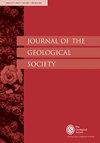A detective duo of apatite and zircon geochronology for East Avalonia, Johnston Complex, Wales
IF 2.6
3区 地球科学
Q2 GEOSCIENCES, MULTIDISCIPLINARY
引用次数: 0
Abstract
The Johnston Complex represents a rare inlier of the Neoproterozoic basement of southern Britain and offers a window into the tectonomagmatic regime of East Avalonia during the assembly of Gondwana. This work presents in-situ zircon (U-Pb, Lu-Hf), apatite (U-Pb), and trace element chemistry for both minerals from the Complex. Zircon and apatite yield a coeval crystallisation age of 570 ± 3 Ma, and a minor antecrystic zircon core component is identified at 615 ± 11 Ma. Zircon Lu-Hf data imply a broadly chondritic source, comparable to Nd data from East Avalonia, and T DM 2 model ages of ca. 1.5 Ga indicate source extraction during the Mesoproterozoic. Zircon trace element chemistry is consistent with an ensialic calc-alkaline continental arc setting and demonstrates that magmatism was ongoing prior to terrane dispersal at 570 Ma. Apatite trace element chemistry implies a sedimentary component within the melt consistent with voluminous S-type granite production during the formation of Gondwana. The similarity of ɛHf and geochemistry between both zircon age populations suggest derivation from a uniform source that did not undergo significant modification between 615 – 570 Ma. Time-constrained apatite-zircon chemistry addresses complexities in dating S-type granitoids (zircon inheritance) and permits inferences on post-magmatic thermal histories. Supplementary material: https://doi.org/10.6084/m9.figshare.c.6484464威尔士约翰斯顿杂岩东阿瓦洛尼亚磷灰石和锆石年代学研究
约翰斯顿杂岩代表了英国南部新元古代基底的一个罕见入口,并为了解冈瓦纳大陆组装期间东阿瓦隆的构造岩浆机制提供了一个窗口。本工作介绍了杂岩中两种矿物的原位锆石(U-Pb、Lu-Hf)、磷灰石(U-Pb)和微量元素化学。锆石和磷灰石的同时代结晶年龄为570±3 Ma,在615±11 Ma处发现了一个较小的前晶锆石核心成分。锆石Lu-Hf数据表明其来源广泛,与来自东阿瓦隆尼亚的Nd数据相当,T DM 2模型年龄约为1.5 Ga,表明中元古代的来源提取。锆石微量元素化学与高硅钙碱性大陆弧背景一致,并表明在570 Ma的地体扩散之前,岩浆作用正在进行。磷灰石微量元素化学表明,熔体中的沉积成分与冈瓦纳大陆形成期间大量S型花岗岩的产生一致。两个锆石年龄群之间的Hf和地球化学的相似性表明,它们来源于一个在615–570 Ma之间没有发生重大变化的统一来源。时间限制的磷灰石-锆石化学解决了S型花岗岩测年(锆石继承)的复杂性,并允许对岩浆后热历史进行推断。补充材料:https://doi.org/10.6084/m9.figshare.c.6484464
本文章由计算机程序翻译,如有差异,请以英文原文为准。
求助全文
约1分钟内获得全文
求助全文
来源期刊

Journal of the Geological Society
地学-地球科学综合
CiteScore
6.00
自引率
3.70%
发文量
68
审稿时长
6-12 weeks
期刊介绍:
Journal of the Geological Society (JGS) is owned and published by the Geological Society of London.
JGS publishes topical, high-quality recent research across the full range of Earth Sciences. Papers are interdisciplinary in nature and emphasize the development of an understanding of fundamental geological processes. Broad interest articles that refer to regional studies, but which extend beyond their geographical context are also welcomed.
Each year JGS presents the ‘JGS Early Career Award'' for papers published in the journal, which rewards the writing of well-written, exciting papers from early career geologists.
The journal publishes research and invited review articles, discussion papers and thematic sets.
 求助内容:
求助内容: 应助结果提醒方式:
应助结果提醒方式:


